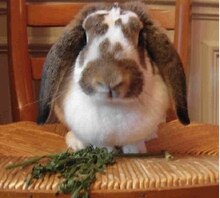French Lop

The French Lop is a breed of domestic rabbit developed in France in the 19th century from the selective breeding of English Lop and Flemish Giant stock.[1] The French Lop resembles the English Lop, but the French Lop is heavier in stature and does not have the exaggerated ear length of the English Lop. Weighing approximately 4.5 kilograms (9.9 lb), it has an average lifespan of five years. The French Lop is currently recognized by the American Rabbit Breeders Association (ARBA)[2] and by the British Rabbit Council (BRC).[3]
History
The French Lop was first bred as a meat rabbit, beginning around 1850 in France.[4] It is believed to have been produced by crossing two existing breeds, the English Lop and the Giant Papillon ("géant papillon français" or "Butterfly Rabbit of France").[clarification needed] The new breed became popular in neighbouring countries including the Netherlands, from which ten specimens were exported in 1933 to the UK for exhibition there.[4] By the 1960s, the French Lop had become a mainstream breed in the UK, and in 1970-1971, the first French Lops were imported into the United States.[4]
Appearance
The French Lop is a very large rabbit, typically weighing around 10-15 pounds, they don't have a maximum weight in the show standard. With lop ears of between 5 and 8 inches long that hang down below the jaw, and an almost cubic appearance with a short thickset body and large head. The front legs are short and straight and the hind legs are carried parallel to the body. The French Lop has a dense, soft coat that comes in two color varieties: solid and broken, and within these categories can be found a number of different rabbit colors, including: agouti, black, chinchilla and fawn.
Behavior
Due to their relatively larger size in comparison to other breeds, the French Lop may require a large hutch/run to move around freely. They fare well in both outdoor and indoor cages but keep in mind they are still rabbits and not dogs; they will chew and you need to bunny proof. They are known to have a placid and relaxed temperament, and can tolerate other species. When socialized well at a young age they are a wonderful family pet, and are very gentle with children. However, French Lops are not for the first-time rabbit owner because they are very large and can be hard to handle. They have very strong back legs, and can cause injury without meaning to, so care should be taken.
You can give a French lop rabbit a companion rabbit, but it is not considered acceptable to house them or any other breed of rabbit with a different species (such as a guinea pig) due to the risk of injury, and a difference in dietary need. Rabbits are highly social animals and should always be kept with a companion [1] - however care should be taken when introducing them as adults. Neutered rabbits will be less likely to fight - male-female pairs tend to be strongest. Like all rabbits, they may go through a "teenager" stage, where they are reaching sexual maturity and might become aggressive. It's less common in the French Lops though than other breeds.
Lifestyle
A French Lop is able to live outside and inside; a large waterproof hutch that shelters the rabbit from any rain, snow, or heat is acceptable with a run attached. French Lops do not handle heat well, so make sure they have adequate protection like a frozen water bottle or a fan. If kept inside, a hutch or a cage can be used. It is infinitely preferable to keep rabbits in pairs - you should only ever consider getting a single rabbit if you can spend several hours a day with them. The rabbits should have a large run for exercise and mental stimulation - lack of exercise can contribute to obesity, gut stasis and behavioural issues.
See also
References
- ^ Bealepark - Wildlife
- ^ "ARBA Recognized Breeds". American Rabbit Breeders Association. Retrieved 18 May 2018.
- ^ "Breed Standards 2016-2020" (PDF). British Rabbit Council. Retrieved 18 May 2018.
- ^ a b c Rabbits: French Lop Rabbit
Information
- Pet Planet Small Breed Profile
- Beale Park Wildlife - French Lop Rabbit
- Omlet Rabbit Breeds Info - French Lop
- French Lop Rabbit Breed History
- Rabbit Breeds Information
